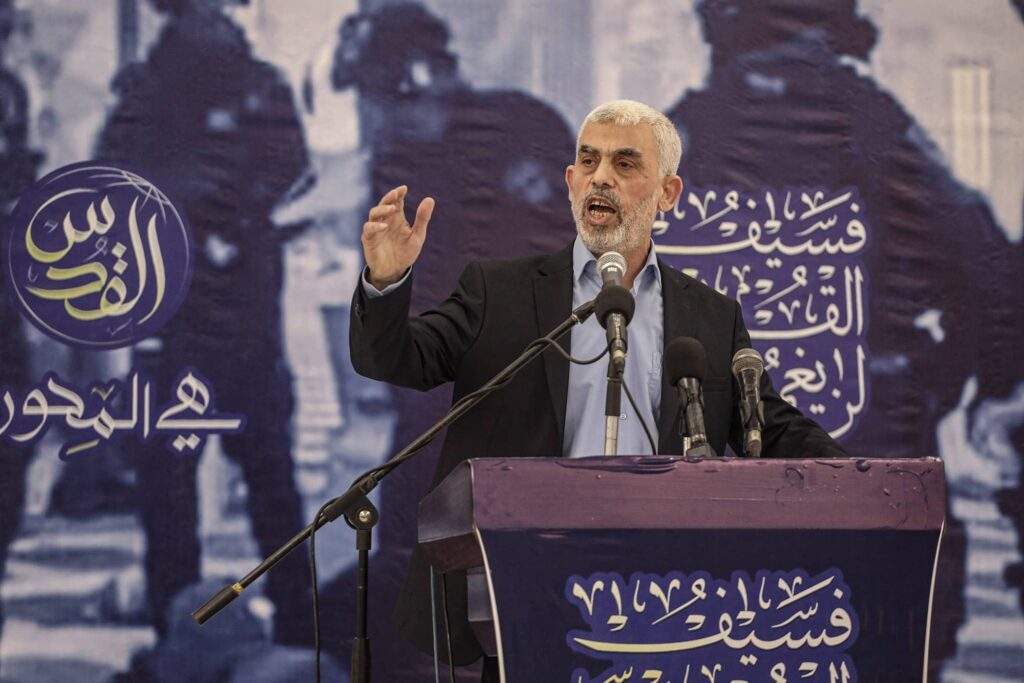Israel’s version of the Pentagon is a twin-towered office complex in HaKirya, the Compound, bordering what used to be the eastern outskirts of Tel Aviv, until 1948 when the city started expanding and flourishing.
On the 14th floor of the complex is a corridor connecting the office suites of the two highest ranking officials. These are the civilian Minister of Defense and the only serving three-star general in the Israel Defense Force (IDF), the Chief of Staff who is dual-hatted as the commander of the army. Only once in Israel’s history was an air force officer elevated to Chief of Staff.
Above and below the 14th floor are the offices of two-star officers in charge of divisions of the general staff, also the commanders of the air force and the navy. It was in a general’s (or perhaps admiral’s) office that a visitor could see on a shelf facing his desk, prominently displayed and basking in a beautiful Mediterranean sunset, a photo of Albert Einstein’s avuncular figure with his quote, “Imagination is more important than knowledge.”
These words of wisdom are not taken lightly by the room’s occupant. Of course, gathering all available facts is essential. Yet mere stock-taking reflects only what has happened up to the moment, with a tacit assumption that tomorrow is going to be pretty much an extension of today, a small step of the linear mind, rather than a giant leap of imagining a totally different future.
This particular general staff officer is now tasked with planning the rebuilding of the IDF once the Gaza War is over, not yet knowing whether it will also flare up into a ground phase of the campaign against Hizbullah or even engulf Iran. In order to do that, his team has to consider the IDF’s road to October and the most terrible military and political failure in Israel’s history.
In taking on the IDF, Hamas punched far above its weight and landed a stunning blow. It also committed horrific war crimes once it breached the Gaza border and targeted civilians, making Israel’s counter-offensive into Gaza both justified and inevitable. This fact should not divert attention from the main question on the mind of every detached observer: how could it happen that Israel’s weakest enemy turned out to be its most lethal. The short answer is a grave failure of imagination.
The Hamas blueprint was known for years: to raid the Gaza border area, attack military outposts, towns and villages, and kill or abduct soldiers and civilians. It echoed a plan touted by Lebanese Hizbullah to invade the Galilee and hold Israeli territory for enough time to show the flag over an army base or a kibbutz, before being repulsed.
It was hardly a secret. Indeed, Hamas units planned for it in daytime exercises that were televised. No deception was involved, except the most painful one, self-deception. No Israeli official believed that Hamas would try to execute the plan.
In 1973, a similar self-deception was at the heart of Golda Meir’s – and Henry Kissinger’s – belief that Anwar Sadat would not dare break a three-year-old ceasefire on the Suez Canal, because surely he knew that he would be humiliatingly defeated. Sadat outsmarted them by going big. Rather than renewing the 1968-1970 War of Attrition of artillery barrages and commando raids, he went for an all-out crossing of the Canal along the entire front. Hamas commander Yahya Sinwar did exactly that, and Israeli policymakers and commanders alike failed to comprehend that what they knew as a Hamas contingency was about to be put into action.
By 2023, Israel thought of Hamas as a nuisance. Israel had developed military-technological solutions to Hamas’s prior bypasses of the land border – rockets and tunnels. It was inconceivable that tiny Gaza would amount to a dangerous reincarnation of the old Egypt.

Learning the Wrong Historical Lessons
Israel’s defense doctrine was hatched three generations ago, under completely different conditions. The IDF of 2023 was caught out of sync between iterations of its post-1948 and post-1973 concepts.
The State of Israel was supposed to be one of two created out of British Mandatory Palestine. The other one was to be a state of the Arab residents of this partitioned land from the Jordan River to the Mediterranean Sea. The Jews of the British Mandate, soon to be called Israelis, reluctantly agreed to this compromise, enshrined in United Nations Resolution 181. But the Arabs, both within the country and outside it, rejected the partition and launched the 1948 War.
The newly established IDF was pitted against five invading armies (with additional contingents supplied by other Arab countries). At war’s end, with armistice agreements signed with four Arab governments (Iraq to this day being the only holdout), Israel started forming its defense doctrine, realistically skeptical regarding the viability of reaching peace accords with its neighbors.
The basic threat facing Israel between 1949 and 1967 was a repeat of the first Arab-Israeli War, but with ever-worsening conditions from Israel’s viewpoint, owing to demographic and technological trends. The nightmare scenario was “Everything, Everywhere, All at Once” – a unified inter-Arab alliance, under Egyptian command, invading simultaneously on all fronts, dismembering the tiny narrow Jewish state while bombers pounded strategic targets. disrupting the mobilization of the IDF main order of battle, the reserves.
The Post-1973 Alignment
After the Yom Kippur War of 1973, with Egypt engaged in a peace process with Israel, there was no longer a western front against Israel, without which there was also no longer an eastern front, since Syria on its own was no match for Israel. Except for a brief clash with Syrian forces in the Beqaa Valley of Lebanon in 1982 with the Israel Air Force lording it over the Syrian surface-to-air batteries and their fighter cover, 50 years have now passed without an Arab-Israeli war in the traditional sense.
Syria remained the threat of reference against which the IDF planned and trained, but the actual security problems were posed by non-traditional sources, various organizations of the Palestinian national movement, plus those with Islam as their main characteristic.
On the bright side of the ledger, Israel was finally free of the existential threat it used to feel from neighboring countries. On the darker side were these nagging hit-and-run attacks, organized or improvised, by Palestinian nationalists or Arab Islamists. To fight them, the IDF morphed into a constabulary, an occupying force fighting terror and guarding settlements and roads rather than the air-and-armor lightning military machine of 1967. This role degraded the IDF’s ability to properly prepare for its other contingencies, as became woefully apparent in the two invasions of Lebanon.
The political lesson of the 1982 invasion of Lebanon was that the Israeli public would not stand for an avoidable war even though Menachem Begin tried to argue that a pre-emptive strike was more effective and less costly than bracing for an enemy’s offensive initiative. Israel may still pre-empt an imminent attack, if it gets wind of it, but will not act against an arsenal being built across the border. The only exceptions were actions to counter weapons of mass destruction, with the two proofs of concept being Iraq 1981 and Syria 2007.
This strategic decision by successive Israeli governments to passively wait for the other side to initiate hostilities, while trying to mitigate the underlying causes, was translated by the IDF into military doctrine. The two pillars were the new emphasis on air defense systems, following Israel’s vulnerability to Iraqi Scud-variants in 1991, and a combination of actionable intelligence and precision-guided munitions. This approach was suited to a casualty-averse IDF in a new age of potentially career-ending media scrutiny.

Mistakes of Vision and Tactics in Gaza
Yahya Sinwar and his planning partner Mohammed Deif emulated Sadat’s approach – and Nasrallah’s ideas – in two central tenets. Firstly, hold your fire patiently, even during an IDF clash with another Gazan militia, so as to lull Israel into the illusion that Hamas is deterred and entice it to divert forces from the border to other fronts and lower the readiness of those remaining. Secondly, go all-out. The shocking ease with which the IDF line at the Gaza border was breached was probably beyond Sinwar’s wildest dreams.
One component of the plan, known by the IDF but discounted, still provides Hamas, seven months into the war, with a winning card: ordering its elite Nuhba troops to haul back into Gaza, mere minutes away, as many hostages as possible to be hidden in the vast tunnel network. Hostages were no longer primarily intended as pawns in a prisoner release deal. Their main use was now as insurance for the Hamas leadership. If Israel was to fear striking its own civilians and soldiers hidden underground, it would be almost impossible for it to hunt down Sinwar and Deif.
Furthermore, the Israeli concept of trying to separate non-combatants from terrorists by pushing residents out of their neighborhoods brought about the catastrophic humanitarian crisis, which in turn produced heavy American pressure. A major mistake, possibly explained by the urge to lessen rocket pressure on Israel’s border towns, was starting the ground campaign in Northern Gaza rather than in Rafah and Khan Yunis.
All these miscalculations add up to the Gaza-lighting of October 7. A lot of soul-searching, politically and professionally, will have to precede a fresh policy and reorganized military, both headed by leaders free of the debacle’s stain. And also, as that General Staff officer agrees, a lot of imagination.



